Perennial curly flowers for the garden
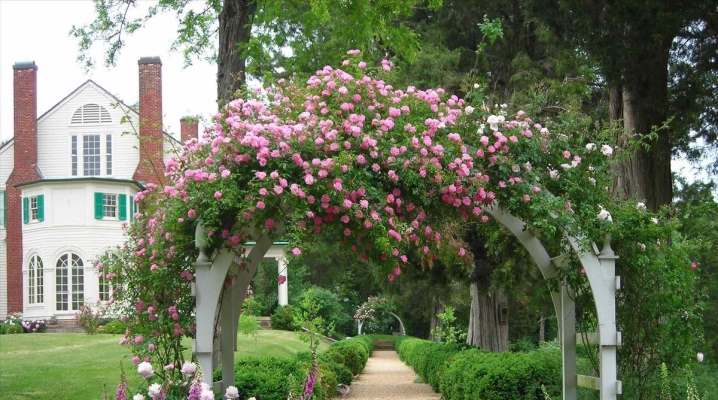
It is difficult to indifferently walk past an arch covered with rose flowers from top to bottom, or past an emerald wall, on which purple and scarlet lanterns - bindweed flowers - "burn". Imagine a cozy house, buried in thickets of clematis and girlish grapes. Unique images are created by perennial climbing plants, which will be discussed in this article.


Features of climbing plants
Planting perennial climbing plants on the site performs several functions.
- Decor. Climbing plants decorate fences, arches, gazebos, walls of buildings well.
- Disguise. Weaving plants will help hide compost pits, old unsightly buildings, barrels of water from prying eyes.
- Protection. By wrapping around the walls of a building, plants will protect it from dust and improve sound insulation.


When choosing weaving perennials for your site, it is necessary to take into account that they are divided into groups: creeping (used for landscaping horizontal surfaces), climbing (they have special suction cups on the stem, with which they are attached to vertical surfaces) and clinging (they must have supports) ...
Consider the supporting structure before planting. Its strength depends on the type of flower. For plants with a thin stem, thin cords, plastic nets can be pulled; with a thick one - more durable metal or wooden structures. For some plants, in addition to support, special clothespins are needed to help fix the shoots on the support.
All this needs to be thought out in advance, long before the acquisition of perennial curly flowers, since they do not like transplanting and will grow in the chosen place for many years.



Popular types
Let's consider in detail the most popular types of plants, used for vertical gardening.
Roses
Among all decorative flowering perennial climbing plants, climbing roses occupy a dominant place. This is a completely unpretentious plant that even an inexperienced florist can grow in his country house. A weaving rose feels great not only in sunny areas, but also on the north side of the buildings.
From time to time, it is advisable to feed the rose with complex fertilizer or mullein infusion, water it abundantly. Before freezing, too long shoots are slightly shortened, wrapped in spunbond and bent to the ground.
There are many types of climbing roses, differing in shape, color, flowering period. There are roses that bloom for only a month, and some delight with their flowering from the beginning of summer to the very frost.
For weaving roses, it is imperative to install trellises or arches, tying lashes to them in a horizontal position - this stimulates the formation of more buds.
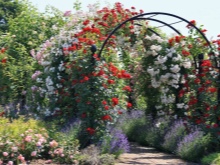
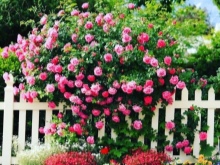

Clematis
The unusually beautifully flowering clematis liana (clematis), like roses, is especially popular with flower growers. The wide variety of species and varieties of clematis includes both small-flowered, but abundantly flowering specimens, and plants with large flowers, sometimes the size of a large saucer. During the flowering of clematis, neither leaves nor shoots of the plant are visible behind the lush mass of flowers.
Clematis beautifully decorates gazebos, fences, perfectly decorate arches. Clematis perfectly clings with petioles and leaf plates to the supports provided to it, which should be less than 3 cm in diameter. A sheet of clematis that is too thick for a trellis will not be able to grasp.By picking up various clematis by the size and color of the flower, as well as the timing of flowering, you can create a continuously blooming wall in your garden.


Wisteria
Wisteria is a creeping vine with a lignified trunk from the legume family, which came to us from Asia. Despite the fact that it is quite sensitive to a decrease in temperature, a southerner, there are some varieties that can withstand forty degrees of frost. Wisteria lashes are very heavy, and reaching 15 cm in diameter, they grow up to 20 meters in length. Therefore, massive high supports should be made for this vine.
It is best to plant this plant near strong stone walls or around pergolas. If wisteria grows along the wall, it can damage parts of the building structure. Wisteria planted near a gazebo or pergola will create a thick shadow, and magnificent fragrant inflorescences-brushes up to 40 cm long in white, purple, lilac, blue shades resembling acacia flowers will hang from above. You can admire the flowering of wisteria from early April to early autumn.


Campsis
Campsis is a fast-growing ligneous vine. Its roots grow in breadth so much that shoots can appear at a distance of several meters from the mother plant. Kampsis blooms all summer long with large tubular, bundled flowers of yellow, orange and red shades. The flowers are very fragrant and attract a lot of insects to the garden. This liana blooms profusely only in open, well-lit sunny areas.
Since campsis grows very quickly, it must be pruned throughout the season. For the winter, he requires shelter. The aerial roots of Kampsis are so strong that they easily penetrate the brickwork, thereby destroying the wall. Therefore, it is best to use this vine to decorate fences, gazebos, arches.

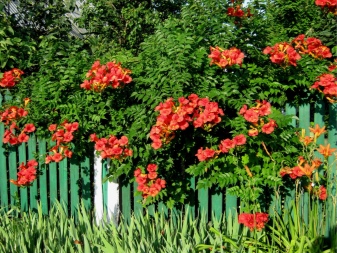
Honeysuckle
Honeysuckle honeysuckle refers to another option for vertical gardening. It is a climbing shrub whose shoots grow up to 8 meters long. The leaf blade is green on top and bluish below. Flowers of white, yellow and red shades are collected in inflorescences at the ends of the shoots. After flowering, decorative juicy berries are formed. Honeysuckle feels great in partial shade and even in the shade, but blooms most abundantly in sunny areas.
Honeysuckle is quite unpretentious, frost-hardy, but does not like transplanting, so it is advisable to immediately plant it in a permanent place, having thought out in advance the composition with honeysuckle. It does not form aerial roots that destroy walls, so you can decorate any vertical structures with honeysuckle: building walls, fences, gazebos, balconies, window openings, terraces.


Maiden grapes
Maiden grape is a vine most often used in urban landscaping of buildings. This fast-growing, powerful perennial plant reaches a length of 20 meters. At the same time, the annual growth can be 3 meters. This liana has suckers and tendrils, with the help of which it "climbs" even on smooth vertical walls. There are varieties of maiden grapes with a variegated leaf color, as well as species that change the color of the foliage in the fall to lemon yellow or crimson red.
Maiden grapes are a completely unpretentious plant: it can grow on any soil, under any weather conditions, without top dressing. This multifunctional vine will decorate any vertical areas, old trees, create good sound insulation, protect from dust and rain. With the help of maiden grapes, you can create beautiful green tunnels, decorate pergolas, gazebos, balconies.
Weeds do not grow under the girl's grapes, and ornamental plants develop well. Therefore, against the background of this liana, you can plant decorative flowering plants such as roses, hydrangeas, phlox.


Ivy
Garden ivy (hedera) is a perennial climbing liana. Some people mistakenly call it a loach (bindweed). In fact, ivy belongs to the Araliev family.
Ivy is valuable for its decorative green and gray foliage with white veins. There are variegated forms of ivy. Depending on the type, heders are short (shoots are only up to 1 meter long) and tall (lianas are up to 30 meters long).
The plant is not demanding on the soil, but does not tolerate constant dryness. Ivy is a thermophilic plant, it must be covered for the winter, and many varieties do not tolerate frost at all, so they need to be kept in the room until spring.
Ivy is widely used in vertical gardening, planting it near the walls of buildings, tree trunks, arches, pergolas, and gazebos.


Hop
Hops are a powerful, fast-growing liana up to 10 m long, in which the aerial part dies off during the first frost. A powerful creeping rhizome overwinters well and does not require shelter. Hops are an unpretentious plant that can grow on any soil, under any conditions, with minimal maintenance. When planting hops on your plot, you need to remember that in the future it will be very difficult to get rid of it, since the root goes into the soil to a great depth. Hops make decorative not only light green foliage, but also the resulting cones, first light green, then brown.
The hop does not require a garter, it wraps around the support with its rough stem. Long-sleeved clothing and gloves should be worn when working with this plant to avoid scratches from the hop shoots.
In vertical gardening, hops are used to hide unsightly places in the garden from prying eyes, to decorate fences, gazebos.


What to choose?
When choosing a perennial climbing plant for your garden, you need to take into account the conditions of detention, the ability to provide it with support, the climatic conditions of the region.
For the inhabitants of Siberia, climbing perennials are suitable, which tolerate severe winters well.
- Maiden grapesthat grows under any conditions without requiring special care.


- Actinidia kolomiktagrowing in taiga forests. This is a vine reaching 15 meters in length. It is decorative due to its leaves that change color throughout the season. In early spring, they are bronze, then the color changes to green, before flowering, the leaves turn half white, and after flowering they turn pink or redden. Actinidia will make an excellent screen dividing the garden plot into the desired zones.


- Daurian moonseed - curly shrub. During the season, the shoots grow to a height of 4 m, by winter they die off almost to the base. Rhizome winters well. After flowering, small black berries are formed. The whole plant is poisonous. In landscape design, it is used for vertical gardening of walls of buildings, hedges.


- Kirkazon (aristolochia) - perennial climbing plant. The decorativeness of aristolochia lies in the unusual arrangement of leaves - they overlap each other like tiles, forming bizarre patterns, and unusual exotic flowers in the form of a curved expanding tube, exuding an unpleasant odor and pollinated by flies, mosquitoes, and beetles. In Siberia, the aboveground part of the kirkazon dies off in winter, but grows quickly in spring, braiding arches, hedges, and gazebos. Aristolochia, as the name suggests, is considered a miraculous medicinal plant.

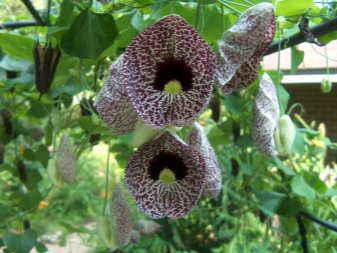
- Regel's triple wing - slow-growing, low deciduous liana. Its height reaches a little more than 2 meters. The plant branches strongly, requires a garter to support. It is better to cover young seedlings from frost, adult plants are frost-hardy enough. You can decorate a fence, a veranda, a gazebo with a three-winged wing.


Options for a beautiful garden design
A garden plot is unthinkable without climbing perennials.

At the gate, you can plant climbing roses, clematis.

The fence will be braided by kampsis, honeysuckle.

The walls of outbuildings are perfectly decorated with ivy, hops.

The residential building will shelter maiden grapes from the weather.

Vertical gardening is an integral part of landscape design.
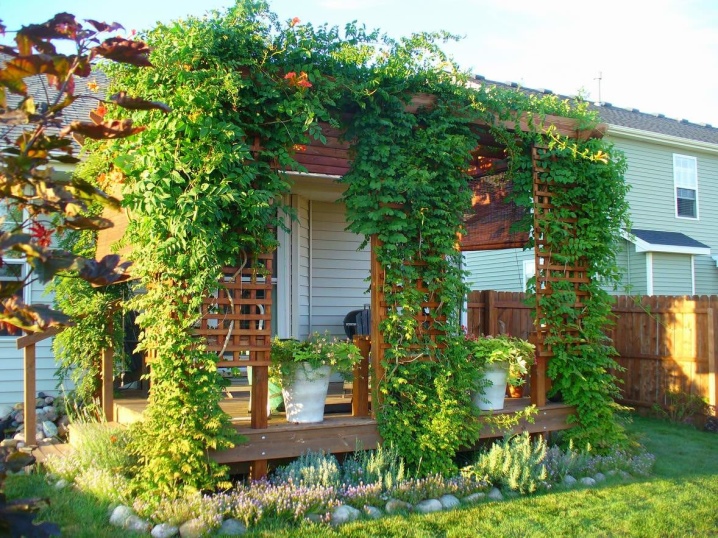
The types of climbing plants are presented below.







































































































The comment was sent successfully.